Double the New York Earned Income Tax Credit

(Photo via the Governor's Office)
As President Trump pushes massive tax cuts for the wealthy our state government should be at the forefront of implementing progressive tax policy to help working families. Expanding the state Earned Income Tax Credit (EITC) is an effective and affordable way to reward work and bring low-income families into the middle class. If Governor Cuomo wants to show that New York can be a progressive beacon in the Trump era, he should push to double the size of the state EITC.
A working parent earning the minimum wage in the Bronx or Schenectady got a much-deserved raise this year and will again next January as a result of increases in the state minimum wage. At the same time that they earn more, however, they pay more in taxes and risk losing valuable benefits such as child care assistance, food stamps, and rental assistance. The EITC helps make up for these losses if they occur.
The EITC is a credit that increases tax refunds and goes up as recipients earn more. For example, this year a single parent with one child earning $17,000 will get a $3,400 federal credit that they can put towards child-care, rent, food, and paying down debt.
Currently, the state-level credit pays 30% of the federal EITC. In 2014, on average families with one child received $666 from the state EITC and families with two kids $1064.
Economists have shown that the EITC leads to both increased employment and decreased poverty by helping over 9 million Americans meet their basic needs. The EITC helps working families join the middle-class, allowing them to pay down debt and build assets. Unlike many economic development projects, which can be ineffective and politicized, the EITC puts cash into the hands of working people in the communities that need consumer spending, economic growth, and jobs.
Policymakers and analysts left, right, and center have supported expanding the EITC. The federal program began under Republican President Gerald Ford and was significantly expanded under President Bill Clinton. In the State Assembly, Democratic Speaker Carl Heastie and the GOP minority leader, Brian Kolb, have both advocated for increasing the credit.
Expanding the EITC will also help make up for New York’s regressive tax system, which burdens the working people more than the wealthy. The Fiscal Policy Institute found that New Yorkers making under $18,000 a year pay 10% of their income in state and local taxes, while families in the top 1% only pay 8% of their income in taxes. An expanded EITC will give back some of the property, sales, and income taxes that working families pay.
Moreover, the federal EITC does not take into account the New York’s high cost of living, which is 15.7% above the national average. An expanded EITC will help alleviate the additional burden that high prices put on low-income New Yorkers.
Doubling the EITC to 60% of the federal credit would be a small portion of the state’s $153 billion budget this year. In 2014 the cost of the EITC was under $1.1 billion and helped over 1.6 million working New Yorkers. Governor Cuomo could easily pay for expanding the EITC by limiting tax deductions and exclusions for high-income individuals and cutting corporate subsidies.
New York’s working families deserve a raise and an opportunity to enter the middle class. Doubling the state EITC is the perfect way to give them a hand up.
***
Devin Gould is a graduate student in public policy at Princeton University’s Woodrow Wilson School of Public and International Affairs. He previously worked at the NYC Economic Development Corporation and was President of the Four Freedoms Democratic Club in Manhattan.
***
Have an op-ed idea or submission for Gotham Gazette? Email This email address is being protected from spambots. You need JavaScript enabled to view it.
Julissa's Choice and Our Responsibility
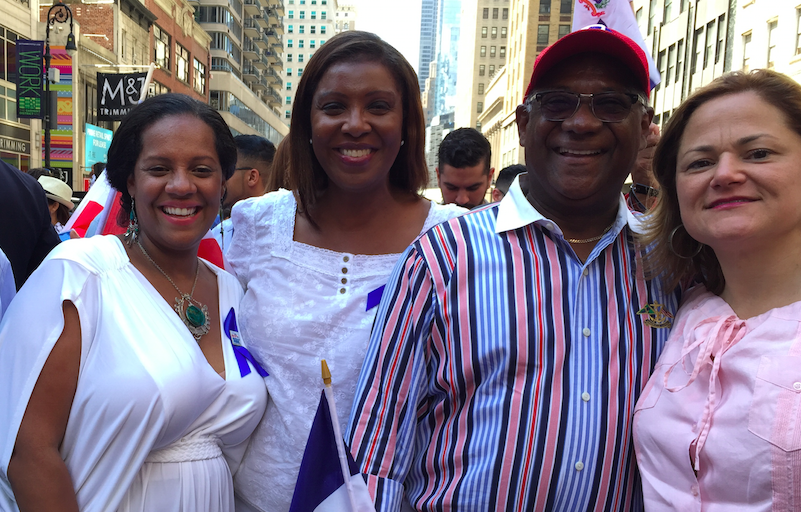
Julissa Ferreras-Copeland, left, & Tish James, the author, center-left
New York City’s political scene is reeling from the shocking news that one of its brightest stars is calling it quits. City Council Member Julissa Ferreras-Copeland announced that she won’t run for re-election so she can spend more time to with her family, which includes her young son.
As the city’s Public Advocate, I’ve worked closely with Julissa as she’s fought with unrelenting passion for the communities she represents. I’ve also watched her closely as she’s balanced the challenges of motherhood and political office.
As her friend and ally, I wholeheartedly support Julissa’s choice to forego re-election, and chance to be the next City Council Speaker. But I’m troubled by the fact that once again, it’s the woman who has to make impossible choices and deep sacrifices in a society engineered to give working men a pass on these matters.
Julissa’s struggle is emblematic of the challenges working women endure as they juggle personal and professional obligations.
While Julissa faced an unusual set of formidable personal circumstances because she and her spouse have been living in different states, her job offered a level of flexibility few women enjoy. The City affords its employees important benefits and Julissa’s powerful position allowed her some autonomy. One might argue Julissa has it better than most working women. But that’s precisely the point – if a gifted politician like Julissa Ferreras-Copeland – chair of the powerful City Council Finance Committee that shapes New York City’s $85 billion budget – has to drop her professional pursuits and make impossible choices, what does that say about other women struggling with even more challenging situations?
Society praises strong, ambitious women and encourages them to “lean in” and lead. But it does so without providing the foundation for their long-term success: adequate family leave, flexible work schedules, and equal pay.
As an elected official, I have pushed for measures and proposed legislation for mandatory paid family leave and banning salary history to close the gender wealth divide, aimed at easing the burden of the balancing act for New York women. However, our national policies and priorities must shift to ensure that women have the support to excel at the highest echelons without sacrificing their personal lives for professional success.
According to the Pew Research Center, when it comes to government supported family leave, the United States ranks dead last, offering no mandatory paid time off. Experts say that parental leave bolsters women’s employment and helps boost future earnings, based on evidence from countries and states with paid leave policies. It increases the likelihood that women will return to their jobs after giving birth, allowing the country to retain some of its best, most industrious talent in the workforce.
There are also clear benefits for generous paid sick leave policies, which ultimately add to companies’ bottom lines by reducing employee absences and departures and improving productivity. Generous gender neutral policies that give working parents and family caretakers paid leave and subsidized childcare aren’t just good for families, they’re also good for business.
Beyond these public policy approaches, as a nation we must reset our collective mindset to imagine a paradigm where women alone don’t have to make gut-wrenching choices between career and family.
Of course, that cannot happen if our leaders don’t reflect the makeup of the
electorate.
With Julissa not returning to the City Council and four female lawmakers term-limited, we could be down to just eight women in the 51-member City Council -- potentially fewer based on the outcomes for some incumbents seeking re-election. This is on top of the fact that only 20% of the U.S. Congress and 25% of our State Legislature is made up of women.
This isn’t a numbers game. And it’s not even about our government. It’s about how our society values working women and what steps we’re willing to take to make it possible for today’s working women to thrive.
As I continue to tackle this issue, I’ll be inspired by Julissa Ferreras-Copeland and the countless other Julissas out there contributing to our workplaces, our families, and our communities with devotion and passion that our society simply cannot afford to overlook.
***
Letitia James is the Public Advocate of New York City. On Twitter @TishJames.
***
Have an op-ed idea or submission for Gotham Gazette? Email This email address is being protected from spambots. You need JavaScript enabled to view it.
New York Votes Act Doesn’t Go Far Enough
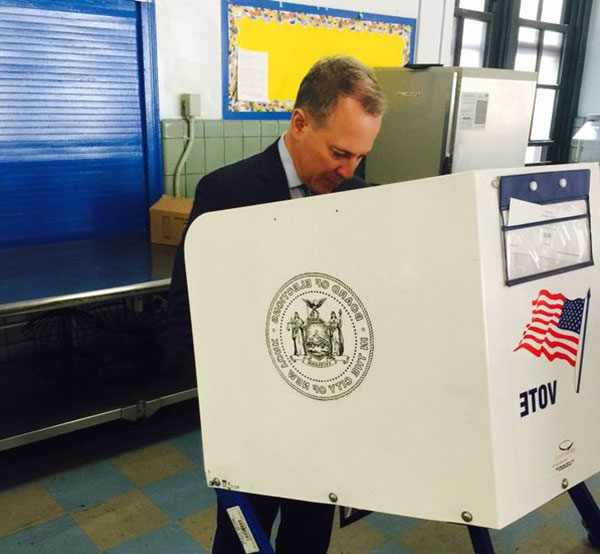
(photo via @AGSchneiderman)
In February, New York State Attorney General Eric Schneiderman introduced the New York Votes Act, a comprehensive set of bills to protect and expand voting rights in New York. Among other issues, the Act includes no-excuse absentee ballots, early voting, and automatic voter registration.
This legislation is a step in the right direction, but I worry that it ignores the most impactful form of voter suppression facing New York: the state’s closed primary system.
About 3.3 million independent and unaffiliated voters are locked out of New York’s closed primaries -- more voters than the Republican Party has enrolled in the entire state!. The system impacts over a million more New Yorkers than automatic voter registration would.
Some argue that independents aren’t technically “disenfranchised” in New York because they still get to vote in the general election. But here’s the thing: New York districts are so uncompetitive -- as a result of partisan gerrymandering -- that over 90 percent of elections are determined in the primary. By the time the general election comes around, most races have already been decided.
Hundreds of thousands of voters were furious when they couldn’t vote in the New York presidential primary last year. Many tried to change their party registration ahead of time, and were still denied a vote, due to this ridiculous rule and the untenable lead time required. New York’s voting laws stifled many new voters or those newly engaged in politics that wanted to participate in our democracy.
I witnessed many of my grassroots organizers and colleagues, people incredibly engaged in the campaign process, not able to vote or forced to vote by affidavit, only to find out later in the mail their vote wasn’t counted. This is exactly what contributes to lower civic and political engagement, and in turn, lower voter turnout.
While Schneiderman originally proposed giving independents the ability to change their party affiliation up to 10 days (in-person) or 25 days (by mail) ahead of a primary, the final version of the New York Votes Act will move the deadline to four months ahead of a primary. If the bill passes, New York would only move from having the longest wait period to change party affiliation to the second longest wait. That’s not reform.
And regardless of the affiliation deadline, the solution fails to address the core reason why so many voters are increasingly becoming independent; they don’t want to join a party for any reason or duration of time. No one should have to register with a party in order to vote in any election. Attorney General Schneiderman even acknowledged that in his report on voting reform, going as far as to recognize that: “Many of these individuals had no interest in affiliating with either of the two major parties” in order to vote. So why make them?
No wonder independent voting rights advocate Francis Barry wrote in a recent op-ed: “New York is the worst state for independents, bar none.” And no wonder New York consistently ranks among the lowest in voter turnout in the country.
There is a strong connection between closed primaries and low turnout in the general. Four of the five states with the lowest turnout in 2016 have closed primaries. The five states with the highest voter turnout in 2016 all use open primaries.
When you lock millions of voters out of the primaries, you can’t expect them to turn out for your party in the general election. That much is obvious. Independent voters want to be a part of the political process from day one, not ignored during the primary or told “join a party if you want to vote.”
The abysmal voter turnout in New York is a large part of the reason why Schneiderman introduced the New York Votes Act in the first place. The day the legislation was introduced, he held a press conference at Federal Hall, where he stood in front of a crowd of voting reform activists and declared his support for any legislation that “makes it easier to vote.”
So why does the New York Votes Act tout automatic voter registration as the centerpiece of reform, rather than the single most impactful issue facing New York voters -- the very issue that has the biggest effect on voter turnout?
What good is automatic voter registration for the general election when the vast majority of races are determined in the primary? And why focus on it at the expense of over 3 million voters who want to vote but don’t want to be forced into choosing a party?
Millions of Americans support open primaries. The current system, in which taxpayers fund closed primaries that exclude huge swaths of voters, is unsustainable. You cannot lock out the second biggest voting bloc in a state from participating in what almost always amounts to the only meaningful round of voting. That’s not democracy.
Primaries are public elections funded by taxpayers. Everyone should be allowed to vote in them, regardless of party affiliation.
As a grassroots activist who organized for Bernie Sanders in four different states -- and have since joined NYPAN and the Democratic Socialists of America -- I’ve heard from hundreds of Americans who are fed up with way the country runs its elections.
That’s why I’m supporting the Open Primaries petition to Attorney General Schneiderman and the New York State Legislature to do the right thing, and expand the New York Votes Act to include open primaries.
Abide by your own words, Mr. Attorney General, and make it easier to vote in New York, for all New Yorkers, by opening the primaries.
Make New York a true democracy.
***
Jeremy Kaplan is an independent filmmaker and political activist.
***
Have an op-ed idea or submission for Gotham Gazette? Email This email address is being protected from spambots. You need JavaScript enabled to view it.
De Blasio’s Jobs Plan Must Create Skilled Workers & High-Wage Careers for New Yorkers
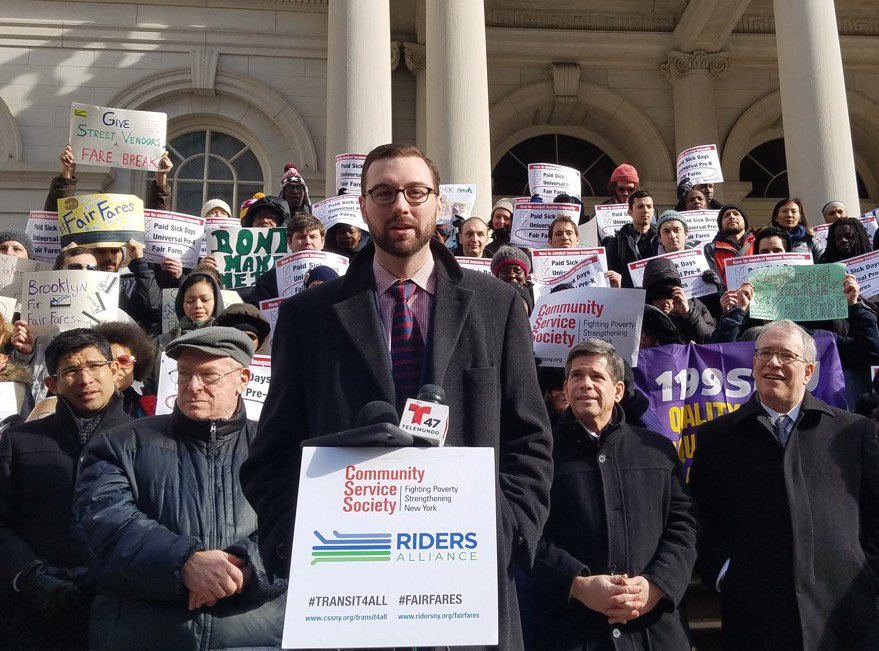
Jesse Laymon, the author
Since Mayor de Blasio unveiled his new target of creating 100,000 new middle class jobs for New Yorkers -- jobs that pay “at least $50,000 a year” -- many have raised questions as to how the de Blasio administration plans to reach that goal. Is this promise just a repackaging of existing job creation or a genuine new effort to invest in growing New York’s middle class?
We in the city’s workforce development community have an answer that would allow Mayor de Blasio to hit this new goal while making real progress towards reducing inequality in New York: don’t count up corporate promises and ribbon cuttings, but focus on graduations and job placements.
That’s because there are two divergent visions for what it means for a local leader to “create jobs” – one that involves questionable accounting of the dubious effects of tax credits and new job sites, and one that involves direct investment in the local residents who can be prepared to fill skilled job openings across the city.
Too often when local governments talk about creating jobs, they’re really talking about moving them around: making a deal with a big employer to trim a tax bill in exchange for the announcement of a new or improved facility located within municipal borders. But when ordinary citizens talk about the need to create jobs, we aren’t talking about the need to count employees whose office moved from Jersey City to Queens or from Chelsea to Sunset Park. We’re talking about helping people who are currently unemployed or underemployed lift themselves up out of poverty with a good-paying job.
To shift the machinery of government from the former to the latter, Mayor de Blasio must first make a change within his administration. Currently, too much of the talk -- and the policy-making -- around “creating jobs” is centered on how to use city-owned property and subsidize new developments. That perpetuates the problem of counting job sites, even new job openings, instead of counting newly employed New Yorkers.
Instead, the mayor should focus on investments in the people themselves, by empowering his Mayor’s Office of Workforce Development (WkDev), an entity whose entire mission is focused on the city’s workers.
If WkDev were given the responsibility for achieving the mayor’s 100,000 jobs promise, and used its authority to coordinate the alphabet soup of city agencies that help unemployed and low-income jobseekers get the training they need, he could achieve his goal in a way that truly reduced inequality. WkDev already has the blueprint to achieve these goals: the city’s 2014 “Career Pathways” plan for investing in job training is a good one, but it sits largely unfunded and lacks a mandate for implementation by those city agencies.
Second, the city needs to get on track towards meeting its most urgent Career Pathways budgetary promise – funding bridge programs. These are hybrid education/job skills courses that help people whose current educational or skills levels are too low to qualify them for immediate job placement or advanced skills courses. For example, a course for English-language learners that teaches English through a focus on healthcare, to prepare its graduates for open positions as home health aides. Or a high-school equivalency course with a focus on the math needed for technology jobs, set up to feed its graduates into an advanced tech skills program with a great track record for high-quality job placements. These bridge programs can launch people into a middle-class career track that they otherwise would be blocked from reaching.
The 2014 plan pledged to devote $60 million annually by 2020 to these courses, but as of the FY 2018 budget the de Blasio administration had only invested about one-tenth that amount. Laying out a funding plan to reach that $60 million target by 2020 would go a long way towards helping currently under-skilled New Yorkers envision a future where they are filling one of the 100,000 good new jobs created by this administration.
Equipping local residents to fill high-quality new jobs won’t be easy; it requires real investment in the city’s own people. But if the administration uses the tools at its disposal, it will take an important step to reducing income inequality in New York.
***
Jesse Laymon is the Director of Policy at the NYC Employment and Training Coalition. On Twitter @JesseLaymon & @NYCETC_org.
***
Have an op-ed idea or submission for Gotham Gazette? Email This email address is being protected from spambots. You need JavaScript enabled to view it.
Bills Fight Smoking by Keeping Pace with Tobacco Companies
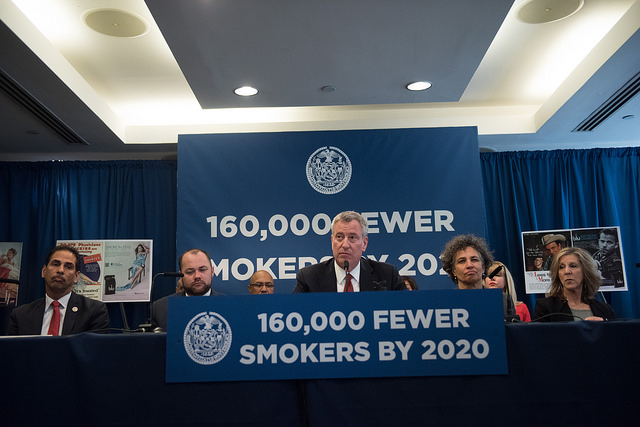
Mayor de Blasio & co. (photo: Michael Appleton/Mayor's Office)
Thanks to aggressive policies and programs over the past decade, the adult smoking rate declined significantly in New York City, from 21.5% in 2002 to 14.0% in 2010. However, to maintain these gains we need to continue to update our tobacco control policies to respond to an ever-changing market where tobacco company strategy attempts to circumvent current regulations.
As a physician whose primary practice involves helping New Yorkers quit smoking, I strongly support the four bills proposed by New York City Mayor Bill de Blasio and City Council members to strengthen the city’s tobacco control policies.
I have seen firsthand the many challenges smokers face when trying to quit. On top of the addictive properties of tobacco products, New Yorkers who smoke are faced with a retail environment that creates cues to smoke on every corner. The widespread availability of tobacco products in retail outlets, along with extensive marketing at the retail point-of-sale, is designed to attract new tobacco users, discourage quitting and create a normative environment that makes tobacco use acceptable and even makes it desirable. To reduce smoking, we cannot simply focus on the individual smoker: we must also change an environment that encourages young people to initiate tobacco use and blocks efforts by smokers to quit. This package of bills moves New York City closer to that goal.
Individually, each of these bills represents an effective method for addressing gaps in current policies. Implemented together, they represent a powerful, comprehensive and synergistic approach to addressing multiple aspects of the retail environment that undermine tobacco tax policy and create environmental triggers to smoke.
One bill would limit new licenses to sell tobacco products, setting caps for retail outlets to sell tobacco products in community districts. It responds to strong evidence that a high-density retail environment in residential neighborhoods is associated with recent initiation of tobacco use among young adults and greater difficulty quitting among smokers.
Another bill in the package prohibits pharmacies or retail stores that contain pharmacies from selling cigarettes and electronic cigarettes, which will act synergistically with the previous bill to further reduce retail density. In 2014, CVS led the way in ending the sale of cigarettes and tobacco products saying that it was “inconsistent with our purpose – helping people on their path to better health.” Although an important step, other national chains have not adopted this policy, creating the need for government action.
There is precedent and evidence supporting the pharmacy ban. Other cities have already passed similar bills—backed by high levels of public support—and subsequent studies demonstrated the link between these bans and reduced retail density in communities.
Finally, the proposal to establish price floors for cigarette packages, other tobacco products and non-tobacco shisha, and to establish taxes on previously untaxed tobacco products, will reduce the likelihood that smokers switch from cigarettes to cheaper products. This will create a tax and price environment that will reduce youth initiation of tobacco use and encourage people to quit.
Unfortunately, the tobacco epidemic is not static. New products are introduced at an alarming rate, the tobacco industry continues to look for loopholes to circumvent tobacco policies, and sometimes policies have unintended consequences that need to be remedied. To continue to achieve our prevention and cessation goals, we must be proactive and keep pace with this changing environment by introducing new laws to fill gaps in current policies, particularly when the evidence points us in the right direction.
The evidence-based policy package put forth by Mayor de Blasio and City Council members represents a tremendous step forward for New York City’s efforts to meet the National Healthy People 2020 goal of 12% smoking prevalence and, most importantly, will prevent individuals—especially young people—from picking up a habit that is much easier to start than to stop.
***
Donna Shelley, MD, MPH is an associate professor of Medicine and Population Health at NYU School of Medicine and leads the smoking cessation service at NYU Langone Medical Center’s Laura & Isaac Perlmutter Cancer Center and directs NYC Treats Tobacco, which helps healthcare organizations help their patients quit. Dr. Shelley has conducted research on health disparities related to tobacco use for over 15 years.
***
Have an op-ed idea or submission for Gotham Gazette? Email This email address is being protected from spambots. You need JavaScript enabled to view it.
The Smart Path Forward in Early Childhood Education
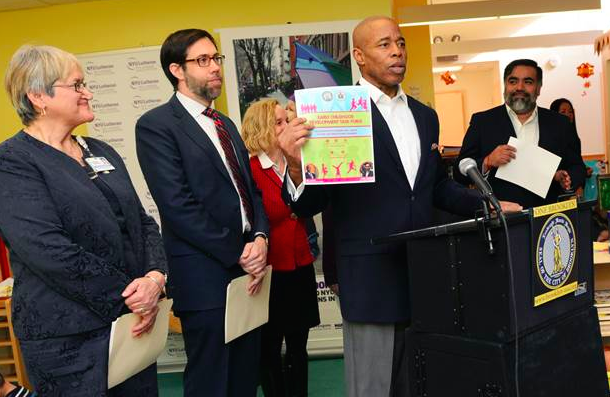
the authors: Eric Adams, at podium, & Daniel Squadron, to his right (Erica Sherman/Brooklyn BP's Office)
In April, Mayor de Blasio announced a new initiative aimed at closing the gap in early childhood education, 3-K for All. The rollout, beginning in historically under-resourced communities like Brownsville and the South Bronx, is projected to provide a seat for every three-year-old living in those parts of the city by fall 2018 – some 1,800 kids. This big step on the road to expanding early childhood development programming across the city is a culmination of years of research and advocacy from civic organizations, community leaders, and think tanks.
Our city is and always has been a place of immense opportunities for academic enrichment, personal fulfillment, and prosperity. But for too long, and for too many, those possibilities have remained out of reach. Unfortunately, disparities begin early in life – and often even before birth.
Research has shown that 90 percent of physical brain development occurs in the first three years of life, and cognitive studies demonstrate the lasting impact of sustained investment in infants’ emotional, mental, and social development. There is also strong evidence that children in home visiting and early childhood programs have decreased criminal justice system involvement, teenage pregnancy rates, special education needs, and social safety net service utilization; with increased high school success and college attendance, as well as maternal employment rates and income. Not only can early childhood investments lead to decreased public expenditure on social services -- they can actually result in increased tax revenues later in life too.
In 2015, we jointly launched the Early Childhood Development Task Force. The Task Force comprised a broad coalition of advocates, community stakeholders, and local hospitals, with an aim to promote the healthy growth of Brooklyn’s youngest, along with their families, as well as help expand existing evidence-based development programs. Partners such as Healthy Families New York (HFNY), Nurse-Family Partnership (NFP), Parents-as-Teachers (PAT), and the Parent-Child Home Program (PCHP) shared crucial information, including difficulties in sharing service information and increasing utilization, especially in many target neighborhoods.
Our findings, released in February of this year, demonstrate the impact of early life interventions on school readiness, emotional and social development, family health, economic growth, and public safety. The evidence is clear: engaging mothers before they give birth through the most formative years results in positive impacts on children’s lives. But to realize the litany of benefits, increased investment and information sharing is critical.
It is crucial that all parents receive information on the availability of resources in their own communities. A multilingual campaign to empower communities with increased information, including resource guides of early childhood services available for parents and guardians and online maps and tools to provide data on nursery and pre-K seat availability in communities where there are an abundance of seats but low participation rates would all be important steps.
In addition, targeted workshops for community leaders including local clergy can help engage and inform hard-to-reach communities about resources available to parents. And, the truth is, this is one area where increased investment should be an easy sell -- since it will more than pay for itself, in lives improved and dollars saved.
3-K for All moves us in the right direction, but we must be even more ambitious about delivering comprehensive early childhood development. We must offer universal services to eligible families before a child is born -- and then continue them from birth to 3-K and onward. This is how we will make the biggest difference for families, not just in their first years of school, but all the way to college, career and beyond.
***
Eric Adams currently serves as Brooklyn’s Borough President. Daniel Squadron currently serves as State Senator for the 26th District covering the Brooklyn Waterfront and Lower Manhattan. On Twitter @BPEricAdams and @DanielSquadron.
***
Have an op-ed idea or submission for Gotham Gazette? Email This email address is being protected from spambots. You need JavaScript enabled to view it.
New York’s Asbestos Courts Need Transparency
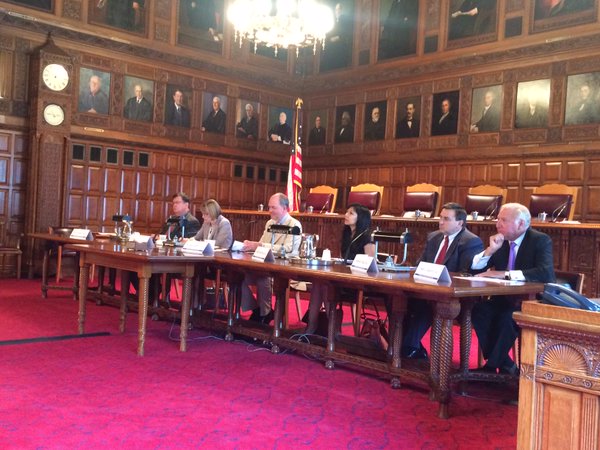
(photo: @NYSCourtsNews)
New York’s asbestos litigation system is broken.
Currently, a procedural loophole in the state’s laws allows a few politically-connected law firms to game the courts and win themselves massive attorneys’ fees by manipulating the truth of their clients’ exposure to asbestos -- intentionally misleading courts and bankruptcy trusts by obscuring the truth.
When a victim of asbestos exposure decides to seek compensation, they can file claims in civil court against the companies they deem responsible, and also seek compensation from the trusts established to handle claims for asbestos manufacturers which have filed for bankruptcy. In theory, the system allows these claimants to be appropriately compensated by all the parties responsible for their exposure.
In practice, however, some lawyers will first file a civil complaint in which they claim a specific company or group of companies are solely responsible for their client’s exposure to asbestos. Once that civil case is concluded – a process that generally takes at least six months and can potentially go on for years – the lawyers often then file multiple bankruptcy trust claims, which present completely new and contradictory claims asserting that multiple bankrupt companies are responsible for their clients’ exposure.
This practice allows lawyers to punish companies in court by placing the full burden of victims’ exposure on a single manufacturer, when in reality, the lawyers know that many other companies were also responsible.
By changing the facts of their claims once the civil portion of the process ends, lawyers are defrauding the bankruptcy trusts and enriching themselves with additional legal fees. The practice obscures the full evidence of the case from the courts and defendants alike, and abuses a system established to fairly and justly offer recompense for victims of asbestos exposure.
No lawyer should be able to falsify the facts of a case simply to line their own pockets, and a legislative remedy to this problem is desperately needed.
Right now, a bill before the New York State Legislature offers a clear solution. Under the Truth, Fairness, and Transparency in Asbestos Litigation Act, all bankruptcy trust claims would be required to be filed within 45 days of the start of any civil action, taking away the opportunity for lawyers to make one claim in court and then present an entirely different story months or years later.
A dozen other states have already beaten New York across the finish line in battling this dishonest practice, including three in just the past year alone. Closing this loophole accelerates compensation for the victims of asbestos exposure, and prevents the fraudulent and blatantly inappropriate misuse of a system designed to help suffering victims and their families.
As quoted by the sponsors of the bill in New York, a federal judge called the use of this practice an “infection” within the legal system, which represents an intentional effort to suppress and obscure evidence during the legal proceedings. Efforts to pass the bill are supported by veterans, lawmakers, business groups, and more, including former judges and lawyers who witnessed these abuses firsthand.
Our legal system is intended to protect all New Yorkers, and to administer justice appropriately and in accordance with the facts of any given case. It’s time for our laws to change and force transparency and honesty into this system, and end this dishonest and indefensible practice.
***
Peggy Ableman is a former judge on the Superior Court of the State of Delaware, with 30 years of experience on the bench. During her tenure on the Superior Court, Judge Ableman presided over the state’s asbestos litigation docket, presiding over more than 500 cases.
***
Have an op-ed idea or submission for Gotham Gazette? Email This email address is being protected from spambots. You need JavaScript enabled to view it.
The Mayoral Control Debate We Should Be Having
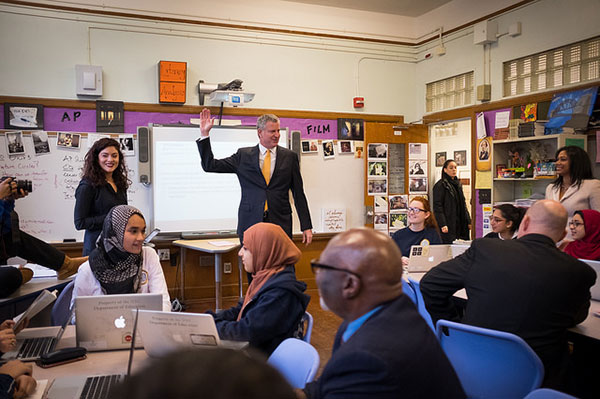
(Credit: Edwin J. Torres/ Mayoral Photography Office)
The annual Rite of Bashage on mayoral control of city schools is upon us. This month, Senate Minority Leader John Flanagan will beat up on Mayor Bill de Blasio for all manner of supposed educational sins before caving to an inevitable extension of mayoral control. Having been soundly whipped by the senatorial wet noodle, de Blasio will walk away a winner.
But there is a real education issue this re-election year that the mayor should be pushed on: the matter of a Chancellor search. The public has a right to know which side of the de Blasio record they’ll be voting on.
In 2012, then-candidate de Blasio criticized the serial secret appointments of Joel Klein, Cathie Black, and Dennis Walcott by Mayor Michael Bloomberg. As reported by City & State at the time, de Blasio said, “Cathie Black was pushed down our throat because of mayoral control gone to an undemocratic level. We need a more democratic—small-d democratic—version of mayoral control, and we need a chancellor who is presented to the public, not just forced down our throat.”
A year later, after being elected, he back-tracked, asserting no such democratic process of public involvement was necessary. Chancellor Carmen Fariña was unilaterally appointed without a public search or vetting.
This election is the first time de Blasio’s flip-flopping can be evaluated by voters. More importantly, the manner of a Chancellor search is not a legislative game of “gotcha” but an imminent matter of real world consequence.
The 74-year-old Fariña has kept her commitment to serve out most if not all of de Blasio’s term. But there is little doubt that she will soon leave. The state law up for June renewal gives the Mayor power of appointment. Thus it is entirely appropriate and practical for the Senate to now inquire how de Blasio intends to use this power and if, in keeping with his past statement, a small-d democratic process should be put in place.
There are good policy positions on either side. Maybe unilateral appointment is preferable, allowing the Mayor full authority and accountability for his pick. But a public process would allow for full vetting of candidates by parents, the general public, and the press, who will all have serious interest and questions about anyone in line for this highly important job.
A full-blown public search occurs in many districts but, if it is believed that some desirable applicants would decline an open process, the Mayor could nominate and the City Council could conduct an open confirmation hearing, as with federal cabinet appointees (and some mayoral appointments to boards and commissions, and the head of the Department of Investigation).
Instead of making a spectacle of this approval process, the manner in which this mayor and future mayors should appoint the Chancellor is a worthy topic, providing the Legislature with an opportunity to put politics aside for an important policy and electoral debate.
***
David C. Bloomfield is Professor of Education Leadership, Law, and Policy at Brooklyn College and The CUNY Graduate Center. He is the author of American Public Education Law, 3d edition, and other published works. On Twitter @BloomfieldDavid.
***
Have an op-ed idea or submission for Gotham Gazette? Email This email address is being protected from spambots. You need JavaScript enabled to view it.
Inside New Yorkers’ Satisfaction, or Lack Thereof, with City Services

(photo: Michael Appleton/Mayor's Office)
New Yorkers are notoriously opinionated, but how often do they get to tell city leaders what they think?
In January the Citizens Budget Commission surveyed 72,000 randomly selected households across the five boroughs to ask about satisfaction with city services and quality of life. More than 10,000 New Yorkers responded and the results speak loudly about the areas where city leaders must focus on improvement.
Overall only 44% of city residents rate city services as “excellent” or “good.” New Yorkers are most dissatisfied with services for homeless people (14% positive), public housing (20%), services protecting at-risk children (23%), and maintenance of streets and roads (39%). Only 20% believe the City spends tax dollars wisely.
Only half of New Yorkers are satisfied with quality of life in the city overall. Grievances include traffic, air quality, street noise, and rat control. Respondents identified infrastructure, safety, housing, and traffic/mobility as the most important issues requiring greater attention from city government.
Demographic information collected also reveal disparities in ratings between white non-Hispanic residents and Hispanic and black residents. White residents are generally more satisfied than Hispanic and black residents: On 13 of 45 indicators, the disparities in ratings exceed 12 percentage points. For example, 74 percent of white residents were satisfied with their neighborhood as a place to live compared to 50 percent of Hispanic and black residents.
These data provide a valuable management tool to citywide elected leaders, and the Citizens Budget Commission will be analyzing and releasing community board results in coming weeks that will prove useful to local elected leaders, as well.
Surveys gauging satisfaction with city services should be a regular part of how the city does business, but city agencies rarely ask their customers to rate their performance. The results add an important lens to the reams of management data regularly collected and reported; these metrics may not be calibrated to capture results that residents actually care about. For example, the Parks Department consistently states that cleanliness and condition of its parks and playgrounds is acceptable in 85% of cases; however, approximately 55% of New Yorkers rate neighborhood playgrounds and parks positively.
The City of New York conducted a broad citywide satisfaction survey only once before, in 2008. CBC believes city government should conduct such a survey regularly to capture vital insights that can guide administrators in improving government performance. The Mayor and City Council should now create and make public a plan for improvement in the areas that city residents found wanting.
***
Maria Doulis is vice president at the Citizens Budget Commission. On Twitter @MariaDoulis and @cbcny. Read the results of the CBC survey here.
***
Have an op-ed idea or submission for Gotham Gazette? Email This email address is being protected from spambots. You need JavaScript enabled to view it.
We Must Pair Raise the Age with Restorative Justice
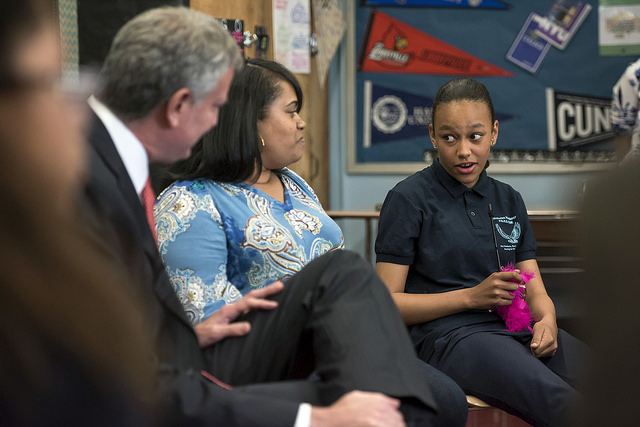
Mayor de Blasio in a restorative circle (photo: Ed Reed/Mayor’s Office)
There has been a great deal of celebration following passage of “Raise the Age,” legislation in New York that will end the practice of trying 16- and 17-year-old criminal defendants as adults. And rightfully so -- this will go a long way to dam the school-to-prison pipeline; we should be cheering. But rarely does a key strategy that helps students make better decisions and avoid arrest make headlines: restorative justice.
Like our justice system, our schools need to move away from overly punitive consequences and invest the resources to implement practices that address the root causes of misbehavior and set students on a path to long-term success.
Students need supports, not suspensions, to grapple with the larger problems that often lead to their misconduct. Students who have experienced trauma come to school carrying emotional baggage that impacts how they act in class. In low-income communities, such as the one I have served for six years, it is not uncommon for students to have suffered trauma from poverty, violence, and discrimination. I have a student who has bounced around foster families. Another student witnessed his dad get beaten by gang members. Relying on inflexible, insensitive, zero-tolerance discipline policies only compounds the mental, emotional, and academic damage from trauma and does not give students the tools to deal with challenges constructively and overcome them.
Even as New York has made a huge push to reduce suspensions, little has been done to support educators like myself to learn alternatives, such as restorative justice practices. Three years ago, I transitioned from my role as a math teacher to a dean. Teachers would send misbehaving students to my office, and I would hear their infraction, and unaware of alternatives, I would administer the punishment school protocol decided was appropriate. But after my first year, I knew detentions and suspensions were not having a long-term impact on student behavior. Unsure of a better way to handle discipline, I leaned on my abilities to foster relationships with students that I had honed as a teacher. As I began to see success with this approach, I sought out methods that leveraged relationships to improve behavior and stumbled on restorative practices.
The restorative approach to discipline is anathema to most educators’ training, and making the shift from punitive to restorative takes time, training, and buy-in.
Although my district offered little guidance, I knew I had to initiate this change for the sake of my students. In my free time I watched restorative justice videos on YouTube and attended external professional development. Transitioning from a punitive mindset, in which I evaluated a child’s misstep and doled out the commensurate consequence, to a restorative mindset, in which I sought to understand and address the cause of the misstep, was transformative. But it was also a difficult journey that could have been made easier with assistance from the district.
Now when students enter my office, they come in knowing we will have restorative conversations seeking to get to the root of the issue that brought them there. Students take responsibility for their actions and together we determine how to heal the situation.
An example of this was a recent fight between two high school students. Instead of suspensions, together they worked on a powerpoint on the perils of fighting and presented their findings to an eighth-grade group. Through this activity, the students learned from their mistakes, repaired the damage, and took responsibility to share their knowledge. That is the power of restorative justice; a suspension could never have achieved these outcomes. Interventions like these have reduced our suspensions by 55 percent. Imagine the difference if every school used restorative justice, and if the resources were there to help them do it.
But the beauty of restorative justice is not just the numbers, it’s the relationships. My teachers have seen the power of these relationships, and are taking it upon themselves to bring restorative justice to their classes. Now educators, and even student leaders, are spearheading restorative justice practices in my school. But they, and others around the state, need help. It’s time that New York build on it’s Raise the Age reforms by training our teachers in positive behavioral interventions that keep our kids in schools, not prisons.
***
Barry Price has been a math teacher, dean, and basketball coach for 11 years and is a member of Educators for Excellence-New York.
***
Have an op-ed idea or submission for Gotham Gazette? Email This email address is being protected from spambots. You need JavaScript enabled to view it.




